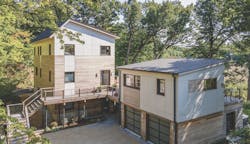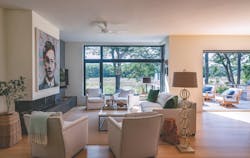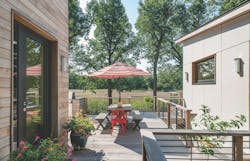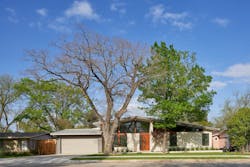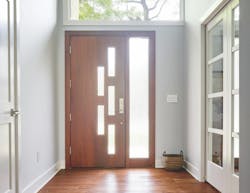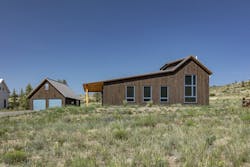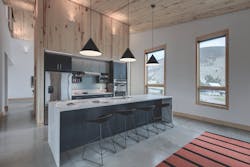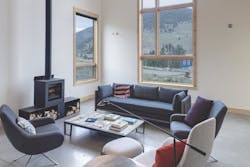Designing and building a custom home to perform at zero net energy—or even positive net energy—requires more than just a few solar panels, although solar is usually part of the equation. High performance goes hand-in-hand with good design. Most building performance pros recommend starting with fitting a house to its site as well as to the owners’ needs. Making sure the structure requires as little energy as possible to keep occupants comfortable means minimizing the size and expense of renewable energy systems.
Many sustainable-design tactics, such as siting and fenestration to amplify or mitigate solar heat gain, don’t add any cost. According to architect Stephanie Horowitz, AIA, managing director of ZeroEnergy Design, in Boston, another crucial aspect involves “listening to clients and interpreting their program to look for ways to incorporate flexible spaces serving multiple purposes and/or transforming over time.”
Creating flexible and transformable spaces isn’t the only future-proofing to consider. As our climate grows more extreme and mechanical systems are updated, building a durable, tight structure allows the house to endure those changes with minimal disruption. Thinking about lifespan and carbon neutrality of systems and materials also is essential. These design and construction strategies work together for a custom home that’s healthy for its owners and better for the planet.
Positive Approach
Horowitz focuses on designing energy-neutral and energy-positive homes that provide her clients with beautiful, comfortable, and healthier shelter—now and well into the future. She launched her firm with a commitment to creating solely net zero or net-positive projects. The firm’s deep understanding of how to achieve high performance, coupled with skill in high design, results in custom homes clients can enjoy for their fine architecture and feel-good sustainability. “Always start with great design—how a home sits on the site, right-sizing to fit clients’ needs, and interpreting their program to incorporate multipurpose spaces,” Horowitz says. “Then get into building enclosure—the net zero workhorse—and finally systems, again making them right-sized for the home. Enclosure, then renewables, is our path to net zero, whether the location is suburban, rural, or coastal.”
That process allows the firm to offset a building’s energy use with a rooftop solar array. And, homes designed by ZeroEnergy Design run completely on electricity, for two key reasons: it keeps the building envelope tight because there’s no need to ventilate combustion gases, and every system in the house can run on self-generated power.
For a house that faces protected marshland in the Boston suburbs, creating a tight envelope while embracing the outdoors required inventive solutions. Given the damp site, the three-story house is built as slab on grade with foundation walls extending up the rear façade where the grade slopes upward. Exterior rigid foam insulation and interior cellulose insulation creates a continuous air barrier. A super-insulation strategy reduces the home’s heat load, allowing for a smaller, cold-climate heat pump supported by a heat recovery system. An offset gabled roof provides added space for photovoltaic panels and results in unique aesthetics inside and out. “The use of less extensive ductwork and a smaller HVAC system let us shift expenses into the enclosure,” Horowitz says. “The two work in concert,” she says, thanks to the mechanical systems designed by her business partner, Jordan Goldman.
Multiple decks on each level of the home offer ever-expanding marsh vistas the higher you go. Primary views face the southwest, where copious amounts of glass allow for solar heat gain. A massive lift-and-slide door links the open kitchen and largest deck, which features a built-in grill, various seating areas, and a bridge to a studio apartment above the garage. The home’s many oversized windows and sliding doors are triple paned, with high solar heat gain coefficients to absorb sunlight, radiating heat inside during winter.
A large mudroom, art studio, and bedrooms for the client’s two children take up the ground floor. Upstairs, open living areas are surrounded by sunny decks, while the primary suite—including a built-in work area, laundry, and private balcony—occupies the third floor. The floor plan gives the adults their own level, so when the children are grown and come back to visit, everyone can enjoy ample privacy and space. Those ground-floor areas can serve other functions or be left unused and unheated when the kids are away. “We wanted to accommodate the soon-to-be young adult children when they’re home,” Horowitz says, “but also not feel too big when the owners are there alone.”
Project: Hingham Marshfront
Architect and Mechanical Engineer: ZeroEnergy Design, Boston
Cabinetmaker: Sharp Woodworking, Canton, Mass.
Solar Installer: My Generation Energy, Hyannis, Mass.
Water Wise
Texas has been battling droughts for more than a decade, according to the U.S. Drought Monitor. So when architect Amy Bramwell’s parents asked her to design them a house that generates its own resources, water reuse was a priority. The house is next door to Bramwell’s own, nestled among a collection of 1950s homes in central Austin. Although the extensive renovation and addition isn’t officially certified—Bramwell’s father built it himself and couldn’t qualify for certification programs—she sees the house perform at net zero energy and water consumption. Her dad was officially recognized as a Net Zero Hero by the city, however, for being the first person in Texas to install a whole-house gray water irrigation system.
“In my professional expertise, the house is truly net zero,” says Bramwell, principal at Studio Steinbomer, in Austin. “It’s super-insulated, with huge overhangs shading triple-pane windows. A ground source heat pump takes care of most energy needs—five geothermal wells in the front yard run the air conditioning and heat water—along with a 9.4 kilowatt solar array. Rainwater irrigates landscape beds, tops off the solar heated pool, and flushes toilets. And gray water is collected from every fixture except toilets and the kitchen sink.”
The City of Austin changed its permitting rules so Bramwell’s father could install this system. It took some back-and-forth with city permitting officials and it’s the one thing her father couldn’t build himself. But, Bramwell adds, her father was highly involved with the plumber and engineer who worked out the complex system. The water is collected from every bathroom sink and shower, the washing machine, and the dishwasher. Her parents use specific shampoos and detergents so water can be filtered and deposited into the yard. Manual valves bypass the system as needed—if bleach is used in the wash, for example. Similar valves also switch toilets from the 6,700-gallon rainwater tanks to city water during dry summer months
Bramwell worked with her parents for two years to perfect the design and incorporate her father’s extensive list of green must-haves. Honoring the neighborhood’s history, the architect drew inspiration from mid-century design icons such as Joseph Eichler. High ceilings make space for abundant glazing shaded by deep roof overhangs that protect outdoor living spaces, which flow seamlessly from inside. A single-story floor plan suits the aesthetic, while allowing for increased accessibility as Bramwell’s parents age in place. Numerous built-ins keep clutter and freestanding furniture to a minimum.
“One aspect of sustainability that should be talked about more is having multigenerational families living close together,” Bramwell says. “It’s been wonderful for us—especially during a pandemic while my twin daughters are young and we both work. And I know that when my parents get to a certain age, I’ll be able to help them, so they can remain in their home and be a daily part of our family for much longer.”
Project: Allandale Mid-Century
Architect: Amy Bramwell, AIA, Studio Steinbomer, Austin, Texas
Builder: Jerry Bramwell, Austin
Mountain Peak Net Zero
In the remote mountain town of Creede, Colo., most single-family homes use either electricity or propane for heating, which can get expensive. And while heating with propane is typically the more efficient option, it can cost thousands per year, which is why heating systems were a priority when architect Avery Augur, owner of Caldera Design Build, was approached to design a net zero house.
Augur has used geothermal systems before, but found installation expensive. He already relies heavily on his go-to engineering firm, Resource Engineering Group, in Crested Butte, to design efficient mechanical systems, so Augur started with them and learned about a new generation of air-to-water heat pump technology the engineers have specified for cold-weather projects with great success. “The SpacePak system can produce 48,000 Btus an hour—heating water to 120° F—out of air as cold as 7 degrees below zero,” Augur explains. “It’s a highly efficient way of producing hot water, which we can use for radiant floor heating.”
The Resource Engineering Group team also calculated the size needed for the solar array. Augur designed the detached garage to fit all 27 panels on the south-facing roof plane. The steep roof sheds snow, so the panels remain unobscured and can capture even low, winter rays. Adding depth to the two-car garage accommodated the entire array while also providing extra storage space inside.
During the first year the home was occupied, Augur and the homeowner collected data to see how well the grid-tied system was working. “The house put 17,000 kilowatts into the grid and only used 10,000 kilowatts,” Augur says. “The highest electricity bill was $70, and $35 is the basic line charge, which you get regardless. For comparison, I just paid a $900 propane bill.”
The main house, like the garage, takes inspiration from the region’s agricultural roots, with simple built forms. The client liked one of Augur’s sketches and developed it to meet his needs. Most of the program fits on the main floor, where a double-height, corner living room anchors the L-shaped building. One leg of the L leads to an open kitchen/dining area, while the other direction leads to the primary bedroom suite, which has two guest rooms that share a bath above it.
A 14-foot-tall, double-pane picture window offers expansive views to the east and fills the living space with morning light. Without air conditioning—like most Creede homes—careful window placement frames views without creating undue solar heat gain. A wraparound porch shades all of the glazing along the southern and western façades.
Augur worked with a frequent collaborator, Denver architect Emily Adams, AIA, founder at Neoera Architecture, on the interior spaces. Bare, polished concrete floors ensure more efficient radiant heating, since nothing is covering the material radiating the heat.
A natural pine tongue-and-groove ceiling is finished with a 1/2-inch shadow gap between the walls and anywhere the boards change direction. This detail makes the ceiling look like it’s floating and lends a modern touch to the rustic material.
Exterior cladding in rough-cut spruce is the result of an enormous beetle kill event in area forests, which enabled Augur to inexpensively source a large amount of the material. The spruce will weather over time and, for a client who embraces this type of patina look, it makes for a low- maintenance, long-lasting exterior cladding.
Project: Engelmann House
Architect and Builder: Caldera Design Build, Creede, Colo.
Interior Architect: Neoera Architecture, Denver
Lighting Designer: Layne Webber, Denver
Structural / Mechanical Engineer: Resource Engineering Group, Crested Butte, Colo.
